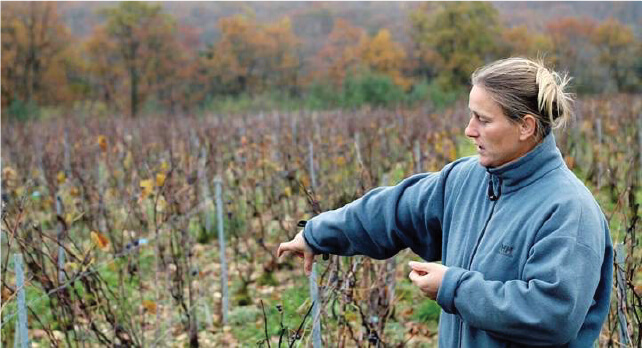Champagne

BENOÎT LAHAYE
Benoit Lahaye is located in Bouzy, a grand cru village in the Montagne de Reims. His family has
been making Champagne there since the 1930’s, and today he works in the winery with his wife
Valérie and their 2 sons.
The domaine, which covers a surface area of 4.8 hectares, is situated in the
regions of Bouzy (3.2 hectares), Ambonnay (1 ha) and Tauxières (0.6 ha). Bouzy brings structure,
power and fruit to the wines while Ambonnay brings acidity and roundness. The estate is mainly
planted with Pinot Noir (just under 90%) on south- and southwest-facing slopes. The vines average
35 to 40 years old. The total production is less than 40,000 bottles per year.
Lahaye uses only his own compost and organic manure to enrich his soil. Various herb infusions are
also applied, along with other fermented extracts from plants and essential oils in order to combat
plant disease. Since 2009, Lahaye has also been applying biodynamic principles to further improve
the expression of his terroir and reveal the full potential of his soil and vines. He says that the
switch to biodynamic practices has brought higher potential alcohol at harvest, but also higher
acidity. His 9-year old work horse Tamise, who became part of the family in 2010, leads Benoit
around the vineyards, plowing the soil and spreading compost.
This superb Grower Champagne is crowned with 2 stars from LVF Green Guide.

FLEURY
Champagne Fleury has been run by the Fleury family for over a century, with each generation
contributing to its reputation for innovation.
In 1901, Emile Fleury became the first grower in Champagne to replant Pinot Noir after phyloxerra. His son, Robert Fleury, then made the unusual decision to bottle his own champagne in 1929. In the 1970s, Jean-Pierre Fleury became concerned about the effects of chemical agriculture on the environment and began experimenting with manual tilling and composting followed by a trial of biodynamic on 3 hectares of the estate in 1989.
Within 3 years he decided to apply those principles to the entirety of his vineyard holdings of 15 ha (90% is Pinot Noir) which makes them the biggest biodynamic producer in Champagne.
In 1993, Gault-Millau elected Jean-Pierre winemaker of the year and the international recognition
has continued. Located in the Côtes de Bar in the village of Courteron, the Fleury estate vineyards
stretch 15 hectares on both slopes of the Seine valley!

RUPPERT-LEROY
Ruppert-Leroy, is a small winery with less than 5 ha of vineyard. It lies at the southeastern limit
of the appellation just 5 km from the border with the Côte d’Or. The domaine’s vineyards have been
farmed organic for the past 30 years. They are now biodynamic, and for a couple of years they have
been making their Champagnes without any added SO2 from A to Z (from the pressed juice to the
bottling).
The turning point was 4 years ago when Gerrad Ruppert and Benedicte Leroy took the decision to
convert the vineyards to biodynamic farming. This led them to the meeting with Jura’s natural wine
legend, Pierre Overnoy. Gerard and Benedicte, unaware of Overnoy’s stature, simply went and knocked
on his door. Overnoy proved extremely generous with his time, explaining and demonstrating how
he captured the magic of his terroir in the bottle.
Throughout the following years, Gerard and Benedicte have ultimately found their own way,
experimenting relentlessly to find what is best for their wine. This includes everything from length
of élevage and minimizing sulfur use to radical ideas of their own. They’ve constructed a new winery
of brick with a wooden roof and wood and straw insulation so that the wines can breathe as much
as possible during ageing. They are using a very lightweight tractor to transport the grapes to the
winery as gently as possible. This allows them to reach the pressoir completely intact, avoiding
pre-fermentation oxidation and lowering the need for sulphur.!

VAL FRISON
Located in Villes-sur-Ayse in the Côtes de Bar, the newly renamed Val’Frisson (previously
Demarne Frison) has been working organically since 2003 and certified since 2007. Covering
only a total of 6 ha, the vineyards are made up of 93% Pinot Noir and 7% chardonnay on
Kimmeridgian and Portlandian soil. Great care is taken to pick the grapes only when they
reach their full maturity to ensure the wines are able to express the special terroir and the
characteristics of the year. Similarly, the winemaking is non-interventionist: fermentation naturally
with indigenous yeast in used barriques, minimal sulphur added only after the malolactic
fermentation, no fining and no filtering. The Champagnes are NV but are always from a single
harvest.
Valerie Frison, owner and winemaker, has a great sense of her area and a true emotional
attachment to her vines. She strives to make the best grapes as possible as it is the key to make
a good wine. ! !